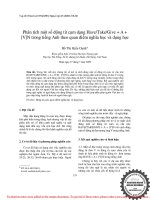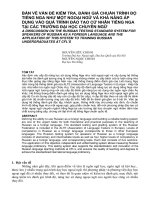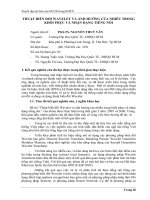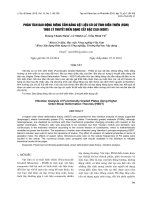Tài liệu tiếng Anh (cao học) Chapter 3 An organization spanning activity
Bạn đang xem bản rút gọn của tài liệu. Xem và tải ngay bản đầy đủ của tài liệu tại đây (313.3 KB, 11 trang )
Chapter 3
Supply Management:
An
Organization
Spanning Activity
3-1
Key Concepts
•
Supply Management with other Internal
Departments
•
Supply Management within the Supply Chain
•
Supply Management: Integrating Suppliers and
Customers
3-2
Supply Management’s Relations with Other
Internal Departments
•
Engineering
•
Manufacturing and Operations
•
Quality
•
Marketing
•
Finance
•
Information technology
•
Logistics
•
Accounts Payable
•
Legal
3-3
Customer
requirements
Internal Interfaces
of the Supply Management Function
Supply
Mgmt
Marketing
Engineering
Material Control Quality
Marketing
Manufacturing
Estimates
Specs.
V.A.
Make
or buy
Supplier
capabilities
Distribution
F
o
r
e
c
a
s
t
s
C
o
n
f
i
g
u
r
a
t
i
o
n
m
a
n
a
g
e
m
e
n
t
Timing
Quantities
P
r
o
d
u
c
t
i
o
n
p
l
a
n
s
S
c
h
e
d
u
l
e
s
P
r
o
d
u
c
t
a
v
a
i
l
a
b
i
l
i
t
y
Q
u
a
l
i
t
y
c
o
m
p
l
a
i
n
t
s
Q
u
a
l
i
t
y
p
r
o
c
e
d
u
r
e
s
I
n
s
p
e
c
t
i
o
n
Source approval
Inspection
Q
u
a
l
i
t
y
m
a
p
P
r
o
d
u
c
t
q
u
a
l
i
t
y
r
e
q
u
i
r
e
m
e
n
t
s
Customers
Suppliers
Figure 3-1
Figure 3-1
3-4
Effect of Different Materials on Productivity and
Cost
Exhibit 3-1
Exhibit 3-1
3-5
Supply Management in Non-Manufacturing
Organizations
•
Supply management often must lead the
requirements process
»
Professionals that often lead the effort in
manufacturing organizations are often not
available
•
Quality implications, time-to-market, pricing
elasticity, technology inflow and continuity of
supply are all still issues
•
These issues combine to have a major impact on
a non-manufacturing firm's sales and bottom line!
3-6
Supply Management in Government
•
Supply management has a major impact on the
efficient and effective use of our tax dollars at all
levels of government
•
Many advances in supply management originated
in the federal government
•
Virtually all of the problems present in
manufacturing organizations are present in
government procurement
3-7
Monitoring the Supply Environment
•
Changes in legislation
•
Wars and other conflicts
•
A consolidation among suppliers
•
Wages, projected wages, labor issues
3-8
Six-step Environment Monitoring Strategy
1. "Determine the cost, supply, and technology
drivers of the materials and services "
2. "Identify the major suppliers and customers of
the materials and services."
3. "Determine the sources of information for those
drivers."
4. "Build a model that predicts the material (or
service) behavior."
5. "Monitor the model to determine its accuracy."
6. "Continuously make improvements as new
relationships are understood and additional data
becomes available."
3-9
Concluding Remarks
•
In assuming greater strategic responsibility, the
activities of supply managers have increased to
include spanning organizational boundaries
•
Efforts to improve do not cease at an
organization’s internal functions, but should span
over the supply chain as well
3-10
END









